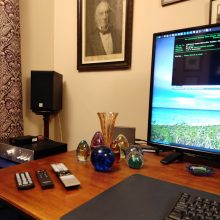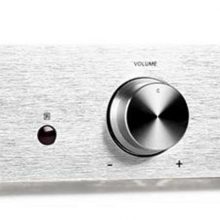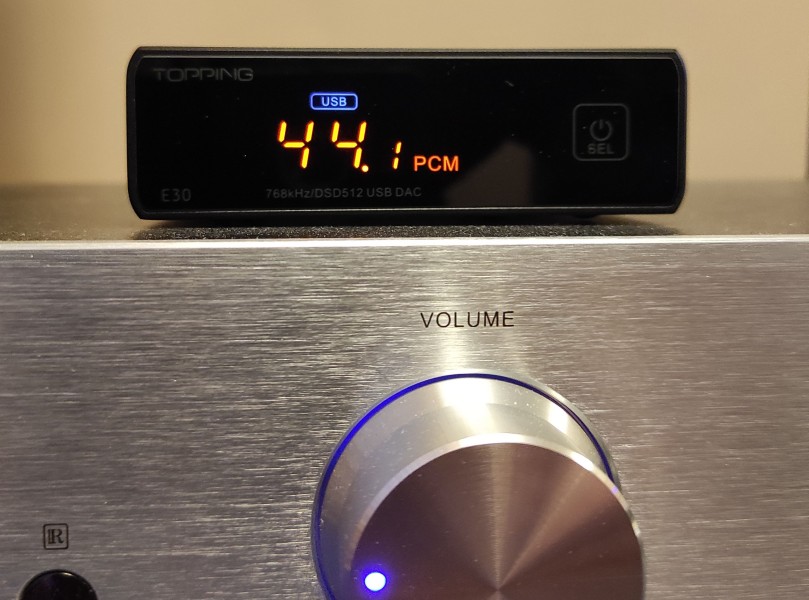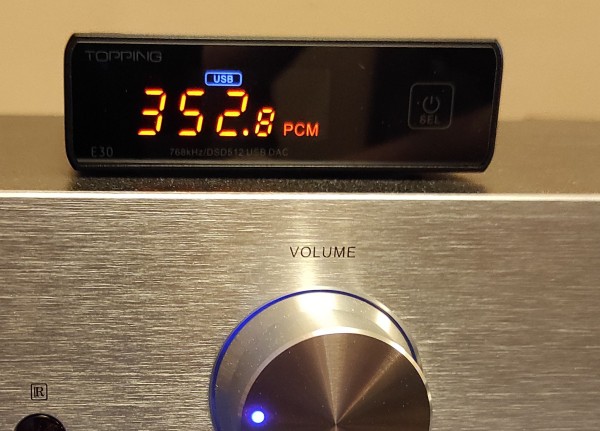 It soon being my birthday (and Christmas having just been and gone), it seemed appropriate to buy myself some presents.
It soon being my birthday (and Christmas having just been and gone), it seemed appropriate to buy myself some presents.
The results are as you see them on the left (which you can click on, to make bigger), which encapsulates the current state of my study's approach to things audio-visual.
We may skip over the small collection of deco glass vases and paperweights, which became something of an obsession during lockdown, and which is only one of three collections in my study. We can also draw a veil over the state of my 'desk protector', which looks like it's in need of a darn'd good wash or wipe-down (I blame the cat's tendency to wander over my desk from time to time as if he owns it)! And pay no attention to my signed engraving of William Gladstone, which I've had for a couple of years now. I would have preferred a Disraeli autograph, but one can't be too fussy about which Victorian Prime Ministers you get autographs from, can you?!
No, instead look at the monitor -which is, in fact, a 43" 4K Toshiba TV I managed to pick up for next-to-nothing in a Black Friday sale in late November from that well-known electrical retailer, Tesco. I'd been thinking about buying a new 24" monitor to go with my existing one, because I never seemed to have enough 'deskspace' to work on things properly, without having to forever drag and re-arrange program windows. Then I happened to walk in for a pint of milk and saw a stack of genuine 4K tellies from a well-known manufacturer, sporting true HDM and a lot of other technical wonder-stuff I doubt I'll ever need to trouble myself about, for what seemed to me to be a silly price of just £199. I don't know if was actually a bargain or not (or whether they were just shifting rubbish old stock!), but given that Curry's PC Warehouse are still selling the same model for a hundred quid more, I think I did OK!

Regardless of value-for-money, the new TV allows me to work sitting well-back from the screen (which has improved my back posture a lot). It has also meant I no longer need to keep putting on and taking off my glasses, which was irritating: now the screen is so far from my face that glasses are required at all times. I think that's a huge improvement in 'lack of fuss' quality!
Next, I draw your attention to the speaker in the corner. Since around 2011, I've used a small Kenwood all-in-one radio, CD and amplifier to do all my music listening. It came with an 'integrated' set of bookshelf speakers, which I've had no real complaints about. I've always known they weren't exactly top-notch, audiophile-credibility-boosting speakers, but they were good enough for my purposes. I was mostly playing music back via the integrated sound chip on my PC's motherboard anyway, so 'audiophile quality' speakers weren't really at the top of my list of urgent spending requirements!
 But, after the best part of a decade of use, I thought it was about time for an upgrade. So I did my research at What Hi-Fi, decided that £3,840 for a pair of Dali Rubicon 2C speakers was a bit much (for that money, I'd want about 18 speakers, not just a pair!), but thought I could stretch to a pair of Dali Speckor 2's, at a much more reasonable £199. Frankly, I'd never heard of "Dali": I had feared Chinese el-cheapos, but it turns out to be a perfectly respectable company, with a broadly-respected product lineup, and a name that turns out to be an acronym for Danish Audiophile Loudspeaker Industries, which gives you a clue as to where they are designed and manufactured. Also, since they've got the word 'Audiophile' in their name, they must be good!
But, after the best part of a decade of use, I thought it was about time for an upgrade. So I did my research at What Hi-Fi, decided that £3,840 for a pair of Dali Rubicon 2C speakers was a bit much (for that money, I'd want about 18 speakers, not just a pair!), but thought I could stretch to a pair of Dali Speckor 2's, at a much more reasonable £199. Frankly, I'd never heard of "Dali": I had feared Chinese el-cheapos, but it turns out to be a perfectly respectable company, with a broadly-respected product lineup, and a name that turns out to be an acronym for Danish Audiophile Loudspeaker Industries, which gives you a clue as to where they are designed and manufactured. Also, since they've got the word 'Audiophile' in their name, they must be good!
I was rather taken aback the first time I played anything through them (which took until a week after delivery, because they don't come with any speaker wires, and I got my maths wrong and only ordered 4 banana plugs, not the 8 required! Details, details...! ). Anyway, as I was say, I wasn't expecting to hear a huge difference over the Kenwood speakers, because my ears just aren't that good. But I easily discerned a warmer, comfier sound than I was used to. Also a much bassier sound: much bassier. I thought for one minute I'd have to turn the bass control down on my amplifier, because it sounded a bit fake and over-done. But I didn't, and it turns out your ears get used to new ambience quirks very quickly. Anyway: they cost me more than I'd have liked (£26 for the banana plugs alone!), but my ears definitely can tell the difference and I'm glad I finally made a proper investment in some decent speakers. For someone who cares about their classical music a lot, it was about time!
Just under the speaker in the above photo you'll see two boxes of audio-electronics goodness to make the speaker purchase a worthwhile one.
 First off, the big silver box: it's an amplifier, with RCA inputs for CD, DVD and AUX. It has controls for treble, bass, balance and volume... but that's pretty much your lot. You don't get a headphone socket, for example. You don't get phono pre-amp, built-in radios or CD players. Unlike its Kenwood predecessor, this box amplifies an audio signal and doesn't try to do anything else. That, and the fact that it's branded as an AUNA, who you've probably never heard of and I certainly hadn't, made it cheap: £99. But it got 4.5 stars from Amazon reviewers and whilst one of those was from someone saying it wasn't worth a damn and he'd sent his back, I can only say that I agree with 5-star ratings. It does what it says it will do on the tin, and does it sufficiently well for me to be happy with the audible results. It has been a more than adequate replacement for the Kenwood, anyway. One feature I shouldn't rave about, but it still brings a smile to my face nearly two months after purchase: the large, rotary volume knob is motorised, so that if you adjust the volume via the supplied remote, the knob turns itsself up or down with a satisfying, but quiet, motor-noise. I like it a lot!
First off, the big silver box: it's an amplifier, with RCA inputs for CD, DVD and AUX. It has controls for treble, bass, balance and volume... but that's pretty much your lot. You don't get a headphone socket, for example. You don't get phono pre-amp, built-in radios or CD players. Unlike its Kenwood predecessor, this box amplifies an audio signal and doesn't try to do anything else. That, and the fact that it's branded as an AUNA, who you've probably never heard of and I certainly hadn't, made it cheap: £99. But it got 4.5 stars from Amazon reviewers and whilst one of those was from someone saying it wasn't worth a damn and he'd sent his back, I can only say that I agree with 5-star ratings. It does what it says it will do on the tin, and does it sufficiently well for me to be happy with the audible results. It has been a more than adequate replacement for the Kenwood, anyway. One feature I shouldn't rave about, but it still brings a smile to my face nearly two months after purchase: the large, rotary volume knob is motorised, so that if you adjust the volume via the supplied remote, the knob turns itsself up or down with a satisfying, but quiet, motor-noise. I like it a lot!
Sitting on top of my new AUNA is a much smaller black box, which I purchased for Christmas to round out my new hi-fi capabilities: it's a Topping E30 Stereo DAC. Again, not a company I'd ever heard of, but the ratings were good, and some research around the Internet indicated that, as DACs go, this isn't a bad one. At £110, it seemed reasonably priced for what it is. Which prompts the question, I guess, what is a DAC?! Well, the name is an acronym for Digital-to-Analogue Converter: it's a box of electronics that takes the digital audio signal out of your PC and turns it into something the AUNA amplifier can send out to the loudspeakers. In effect, it does exactly what most PC sound cards or built-in sound chips do -but it does it outside of your PC, rather than in it. Given that PCs can be electronically noisy environments, taking the conversion process out of the PC should result in somewhat 'cleaner' music signals. The other reason I wanted to ditch my sound card was that you've basically no way of knowing precisely what it's doing: it's tucked inside your PC and tends not to display what it's up to, apart from responding to a software volume control. This DAC, however, shows you the quality of the audio it's receiving:

Here, I'm playing (via my very own AMP player, as you can see on the monitor in the earlier image!) a standard FLAC, produced as a rip from a standard CD: so it's showing that it's a 44.1Khz signal, PCM. But I can also play it some hi-res music files and see the display change to something like this:

I haven't quite worked out all the ins and outs of the tool as yet: what precisely gets displayed at any given time seems to depend on the day of the week and the prevailing wind direction... but I'm getting there.
In the meantime, it's precisely to be able to experiment with 'hi-res audio' in this way that I wanted to go the external DAC route in the first place... and I can report that I can tell the difference between hi-res audio and down-converted, standard-res copies: and I don't like the hi-res versions! To my ears, they are the audio equivalent of zooming into a photograph printed in a newspaper so that all you end up seeing are the individual blobs of ink. The detail in a high-res recording is definitely impressive: but it is so detailed that it sounds 'grainy' and 'bitty' compared to the smooth sounds of the down-converted equivlents. I still buy hi-res audio recordings because, usually, they have been mastered differently from old CD equivalents released back in the 1980s, and the remastering dramatically improves the listening experience, regardless of whether you listen to it as hi-res or standard-res rips. But I won't be abandoning my practice of down-converting high-res audio recordings back to standard CD-res any time soon, that's for sure! To be fair, it's possible that a £100 amplifier and some £199 speakers simply aren't good enough to reproduce hi-res audio well... but if listening to 'good' hi-res audio requires me to spend several hundred pounds more, it's a non-starter for me (and for others with not-unlimited wallets, too, I suspect!)
Anyway: that's a bit of a sidetrack. The fact is, the Topping E30 lets me do those sorts of experiments, which I haven't been able to do before now, so it was a worthwhile buy. Out of interest, you plug it into your PC as a new USB device. Even on my Manjaro Linux box, the thing was autodetected and used by all applications without bother.
So: that was my late last-year and birthday splurge on myself. I now have a great monitor and an excellent audio system that makes me productive and happy at the same time, which has got to be a bonus! Money well-spent, therefore. Even if it was a little more than I initially thought it was going to be!